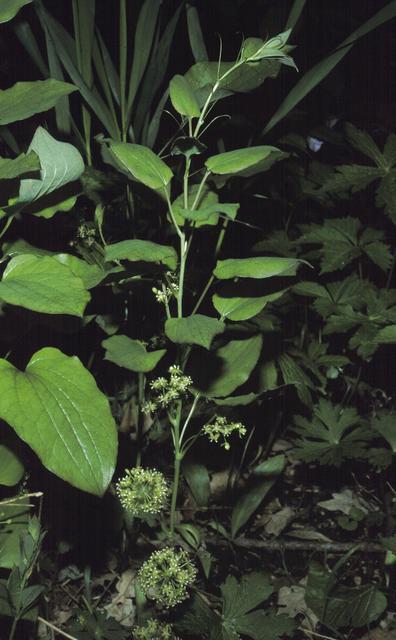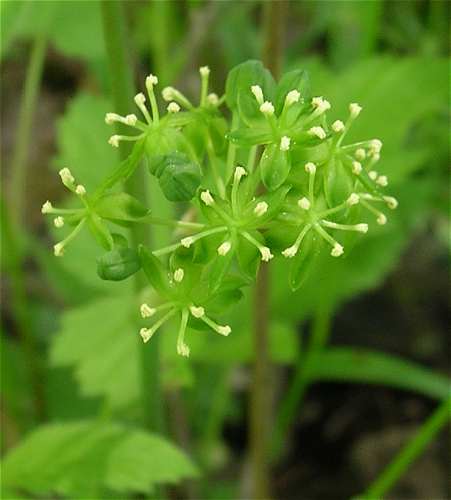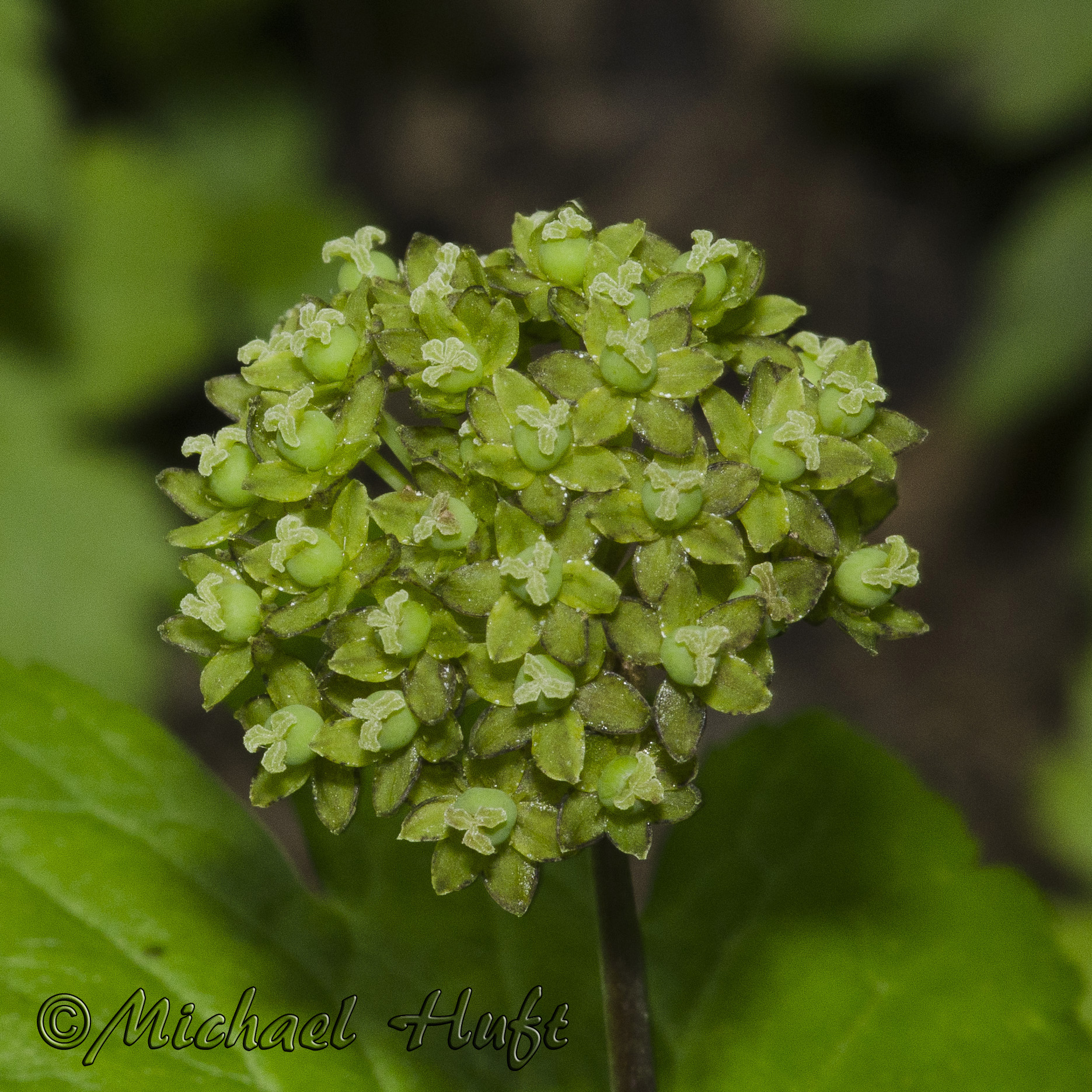 Download PDF
Download PDF
Name: Smilax illinoensis Mangaly
Family: Smilacaceae, the Greenbrier Family
Common Names: Carrion-flower, Illinois carrion-flower, Illinois greenbrier (1,3,5).
Etymology: Smilax is the Greek word for “clasping”, and illinoensis means “from Illinois” (5).
Botanical synonyms: None found.
Quick Notable Features (5,7):
¬ Erect herb with unarmed stems; tendrils near the apex of the plant
¬ Alternate leaves with parallel veins
¬ Petioles as long as the leaves or longer
¬ Axillary umbellate inflorescences of only pistillate or staminate flowers on each plant
¬ Flowers with 6 green to yellowish tepals
Plant Height: Usually 0.5-1 meter tall (2).
Subspecies/varieties recognized: None found.
Most Likely Confused with: Smilax ecirrhata, S. herbacea, S. rotundifolia, S. hispida, S. lasioneura, Dioscorea villosa, Menispermum canadense.
Habitat Preference: The Illinois greenbrier is usually found near roads, in forests, thickets, and in proximity to rivers (1,5,7).
Geographic Distribution in Michigan: S. illinoensis occurs in most counties of the southern half of the Lower Peninsula, and in Antrim, Delta, Marquette, Ontonagon, and Gogebic counties in the north (1).
Known Elevational Distribution: The species occurs between 150-600m above sea level (2).
Complete Geographic Distribution: Native to North America, the Illinois greenbrier is found in AR, IA, IL, IN, MI, MN, MO, NE, OH, WI, and ON (Canada) (3).
Vegetative Plant Description: S. illinoensis is an erect herbaceous monocotyledon with perennial rhizomes, and unarmed, unbranched stems. The paired stipules are 0.4-0.9 cm long and adnate to the petiole about half its length. The petioles are as long as the leaf blades or longer, and the petioles of the upper leaves bear a pair of poorly developed tendrils near the petiole base. Leaf axils with tendrils rarely develop inflorescences. The leaves (rarely more than 25 per plant) are alternate and spirally arranged, simple, ovate with round, truncate, or subcordate bases, acute to acuminate apices, pubescent below, 2.3-20 cm long and 1.1-8.5 cm broad. The 3-5 parallel veins emerging from the top of the petiole arch smoothly to the apex where they unite again, and are covered in minute white hairs. Finer veins have a slightly reticulate pattern (1,2,5,7,10,11,14,15, C.V. Santanna pers. obs. of herbarium specimens from the University of Michigan Herbarium).
Climbing Mechanism: The species climbs using the paired tendrils near the petiole base of the plant’s upper leaves (10,11).
Flower Description: S. illinoensis is dioecious. The round umbels (3-10 per plant) usually bear 25-60 flowers each, but occasionally as few as 10 flowers per umbel. The inflorescence peduncles are longer than the petioles by at least 2cm, and are borne on the lower nodes of the plant, axillary  to a bract (2.5-7 cm long) or leaf. The greenish yellow flowers are unisexual, radially symmetrical, with 6 tepals in 2 whorls, each imbricate tepal 3.5-4.5 mm long, free and deciduous. Staminate flowers on 1.1-1.2 cm long pedicels bear 6 stamens with filaments longer than the anthers, inserted at the base of the tepals. Pistillate flowers on 1-1.4 cm long pedicels have 6 staminodes, a 3-carpellate superior ovary topped by a very short style and 3 spreading stigmas; each locule bears 2 ovules (1,2,5,10,11, C.V. Santanna pers. obs. of herbarium specimens from the University of Michigan Herbarium).
to a bract (2.5-7 cm long) or leaf. The greenish yellow flowers are unisexual, radially symmetrical, with 6 tepals in 2 whorls, each imbricate tepal 3.5-4.5 mm long, free and deciduous. Staminate flowers on 1.1-1.2 cm long pedicels bear 6 stamens with filaments longer than the anthers, inserted at the base of the tepals. Pistillate flowers on 1-1.4 cm long pedicels have 6 staminodes, a 3-carpellate superior ovary topped by a very short style and 3 spreading stigmas; each locule bears 2 ovules (1,2,5,10,11, C.V. Santanna pers. obs. of herbarium specimens from the University of Michigan Herbarium).
Flowering Time: May-June (2,7).
Pollinator: Smilax lasioneura, a closely related species to S. illinoensis, is pollinated by flies attracted to the carrion smell of the flowers (13). The pollen morphology of these two species is very similar (12). Also known as the Illinois carrion-flower, it is likely that S. illinoensis is also pollinated by flies or other insects, although no mention of the carrion odor was found in literature.
Fruit Type and Description: The fleshy fruits are small, globose, blue to black berries 4-7 mm across, each bearing 1-6 seeds (2,8,10,14,14, C.V. Santanna pers. obs. of herbarium specimens from the University of Michigan Herbarium).
Seed Description: The seeds are brownish in color and contain a small, oblong embryo. There is a protuberance at the apex of each seed (8).
Dispersal Syndrome: Other species of Smilax in Michigan are dispersed by birds that consume the fruits (9). No specific information on seed dispersal was found for S. illinoensis, but it is likely dispersed by birds based on very similar fruit morphology to its congeners.
Distinguished by: S. ecirrhata has erect stems usually no taller than 50cm, tendrils are absent, leaves are basally cordate, petioles are usually longer than the peduncles, and there are fewer than 25 flowers per umbel. In contrast, S. illinoensis is usually taller than 50cm, tendrils are present, leaves are basally round, truncate, or subcordate, petioles are shorter than the peduncles, and there are usually more than 25 flowers per umbel. S. herbacea, S. rotundifolia, and S. hispida have  abaxially glabrous leaves, stems longer than 1m, and tendrils are fully developed while the leaves of S. illinoensis are pubescent below, the stems are less than 1m long and erect, and the tendrils are poorly developed. S. rotundifolia and S. hispida stems become woody and armed with prickles while S. illinoensis is herbaceous and unarmed. Additionally, S. rotundifolia fruits are glaucous, distinguishing it from S. illinoensis. S. lasioneura has branched stems longer than 1m, with fully developed curling tendrils, also present at nodes with inflorescences, and the petioles are shorter than the leaves. S. illinoensis has unbranched stems, the tendrils are only present on the leaf axils of the uppermost leaves where inflorescences are absent, and the petioles are the same length or longer than the leaves. Dioscorea villosa is herbaceous and climbs by twining around other plants (tendrils are absent), the leaves are basally cordate, the inflorescence is paniculate, and the pistillate flowers have an inferior ovary that develops into a capsule with winged seeds. S. illinoensis inflorescences are umbellate and the pistillate flowers have a superior ovary that later develops into a berry. Menispermum canadense can become a woody vine with alternate slightly peltate leaves that are basally cordate and can be shallowly lobed. The unisexual flowers have a 4-8-parted calyx and a 6-8-parted corolla; staminate flowers bear 12-24 stamens, and pistillate flowers produce a dark glaucous drupe. S. illinoensis leaves are neither peltate nor lobed, its flowers have only 6 tepals, and the staminate only 6 stamens (1,2,10).
abaxially glabrous leaves, stems longer than 1m, and tendrils are fully developed while the leaves of S. illinoensis are pubescent below, the stems are less than 1m long and erect, and the tendrils are poorly developed. S. rotundifolia and S. hispida stems become woody and armed with prickles while S. illinoensis is herbaceous and unarmed. Additionally, S. rotundifolia fruits are glaucous, distinguishing it from S. illinoensis. S. lasioneura has branched stems longer than 1m, with fully developed curling tendrils, also present at nodes with inflorescences, and the petioles are shorter than the leaves. S. illinoensis has unbranched stems, the tendrils are only present on the leaf axils of the uppermost leaves where inflorescences are absent, and the petioles are the same length or longer than the leaves. Dioscorea villosa is herbaceous and climbs by twining around other plants (tendrils are absent), the leaves are basally cordate, the inflorescence is paniculate, and the pistillate flowers have an inferior ovary that develops into a capsule with winged seeds. S. illinoensis inflorescences are umbellate and the pistillate flowers have a superior ovary that later develops into a berry. Menispermum canadense can become a woody vine with alternate slightly peltate leaves that are basally cordate and can be shallowly lobed. The unisexual flowers have a 4-8-parted calyx and a 6-8-parted corolla; staminate flowers bear 12-24 stamens, and pistillate flowers produce a dark glaucous drupe. S. illinoensis leaves are neither peltate nor lobed, its flowers have only 6 tepals, and the staminate only 6 stamens (1,2,10).
Other members of the family in Michigan (number species): Smilax (5) (source 1).
Ethnobotanical Uses: None found.
Phylogenetic Information: Smilax illinoensis is included here in the Smilacaceae family, which is in the Liliales order, part of the Monocotyledoneae clade of Angiosperms. The Smilacaceae is often classified as a subfamily in an expanded Liliaceae. The Liliales order includes 10 other families: Corsiaceae, Campynemataceae, Melanthiaceae, Petermanniaceae, Colchicaceae, Luzuriagaceae, Alstroemeriaceae, Rhipogonaceae, Philesiaceae, and Liliaceae. Smilacaceae is a family of vines and lianas that often bear spiny stems; members of the family can be found in tropical and temperate regions in all continents but Antarctica (4).
 Interesting Quotation or Other Interesting Factoid not inserted above: “Smilax illinoensis is intermediate between S. ecirrhata and S. lasioneura” (2) and it is many times erroneously identified as one of the latter in herbarium collections (12). S. illinoensis is placed within the Smilax herbacea complex, which was subdivided by Mangaly into the climber and the erect groups. S. illinoensis is part of the erect group together with S. biltmoreana, S. ecirrhata, and S. hugeri (6). The mean pollen size of S. illinoensis is 25.54 microns. The tendrils in Smilax originate from splitting petioles (12). “… it is concluded, on the grounds of anatomy and external morphology, that these tendrils are equivalent to the petiole in morphological value, and have arisen through chorisis or dédoblement of that organ” (16).
Interesting Quotation or Other Interesting Factoid not inserted above: “Smilax illinoensis is intermediate between S. ecirrhata and S. lasioneura” (2) and it is many times erroneously identified as one of the latter in herbarium collections (12). S. illinoensis is placed within the Smilax herbacea complex, which was subdivided by Mangaly into the climber and the erect groups. S. illinoensis is part of the erect group together with S. biltmoreana, S. ecirrhata, and S. hugeri (6). The mean pollen size of S. illinoensis is 25.54 microns. The tendrils in Smilax originate from splitting petioles (12). “… it is concluded, on the grounds of anatomy and external morphology, that these tendrils are equivalent to the petiole in morphological value, and have arisen through chorisis or dédoblement of that organ” (16).
Literature and websites used:
- Michigan Flora Online. A.A. Reznicek, E.G. Voss, & B.S. Walters. February 2011. University of Michigan. Web. December 12, 2013. http://michiganflora.net/species.aspx?id=2690.
- Holmes, W.C. 2003. Flora of North America, Vol. 26: 227. Smilacaceae. http://www.efloras.org/florataxon.aspx?flora_id=1&taxon_id=242101934
- USDA, NRCS. 2013. The PLANTS Database (http://plants.usda.gov, 12/12/2013). National Plant Data Team, Greensboro, NC 27401-4901 USA.
- Stevens, P.F. Angiosperm Phylogeny Website. Version 12, July 2012. http://www.mobot.org/mobot/research/apweb.
- Robert W. Freckmann Herbarium 2013. Smilax Illinoensis. University of Wisconsin, Stevens Point. http://wisplants.uwsp.edu/scripts/detail.asp?SpCode=SMIILL
- Fu, C., H. Kong, Y. Qiu, & K.M. Cameron 2005. Molecular phylogeny of the East Asian–North American disjunct Smilax Sect. Nemexia (Smilacaceae). International Journal of Plant Sciences 166(2): 301-309.
- Mohlenbrock, R.H. 2002. Vascular Flora of Illinois. USA: Southern Illinois University Press.
- Britton, N.L. & H.A. Brown 1970. An Illustrated Flora of the Northern United States and Canada: Volume I. New York, NY: Dover Publications, Inc.
- Thompson, J.N. & M.F. Wilson 1979. Evolution of temperate fruit/bird interactions: phenological strategies. Evolution. 33: 973-982.
- Fernald, M.L. 1950. Gray’s Manual of Botany, 8th ed. New York: American Book Co.
- Judd, W.S. 1998. The Smilacaceae in the Southeastern United States. Harvard Papers in Botany 3(2): 147-169.
- Mangaly, J.K. 1968. A cytotaxonomic study of the herbaceous species of Smilax: section Coprosmanthus. Rhodora 70(781): 55-82.
- Fontenelle Forest 2008. Nature Search: Smilax lasioneura. http://www.fnanaturesearch.org/index.php?option=com_naturesearch&task=view&id=389
- Yatskievyck, G. 1999. Steyermark’s Flora of Missouri, Volume I. St. Louis, Missouri: Missouri Botanical Garden Press.
- Mohlenbrock, R.H. 1970. Flowering Plants: Lilies to Orchids. USA: Southern Illinois University Press.
- Arber, A. 1920. Tendrils of Smilax. Botanical Gazette 69: 438-442.
Image Credits (all used with permission):
- Image of whole plant courtesy of Kay Yatskievych
- Image of apex of the plant with tendrils taken at the University of Michigan Herbarium, courtesy of Cristine V. Santanna
- Image of staminate inflorescence courtesy of Merel R. Black, University of Wisconsin Stevens Point http://wisplants.uwsp.edu/scripts/detail.asp?SpCode=SMIILL
- Image of developing fruits copyright Michael J. Huft
- Image of fruits taken at the University of Michigan Herbarium courtesy of Cristine V. Santanna
- Image of rhizome taken at the University of Michigan Herbarium courtesy of Cristine V. Santanna
- Species distribution map, derived from the Michigan Flora Online.
PRIMARY AUTHOR: Cristine V. Santanna with revisions and editing by John Bradtke and Robyn J. Burnham.
© Robyn J. Burnham
For additional information on Michigan Plant Diversity species accounts, please contact Robyn J. Burnham via email: rburnham“at”umich.edu